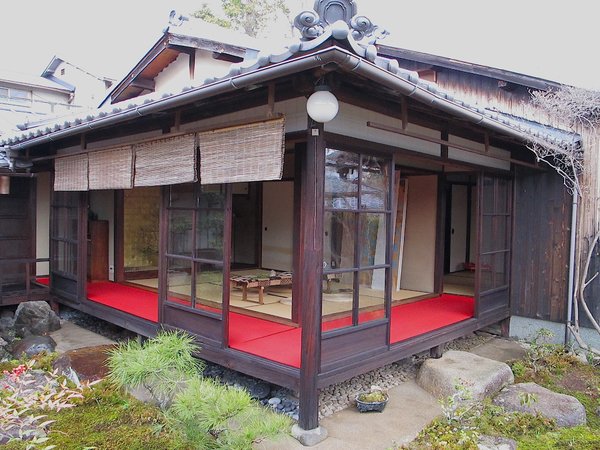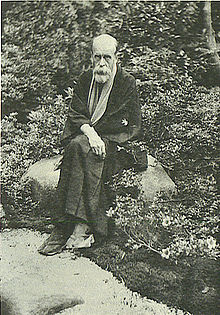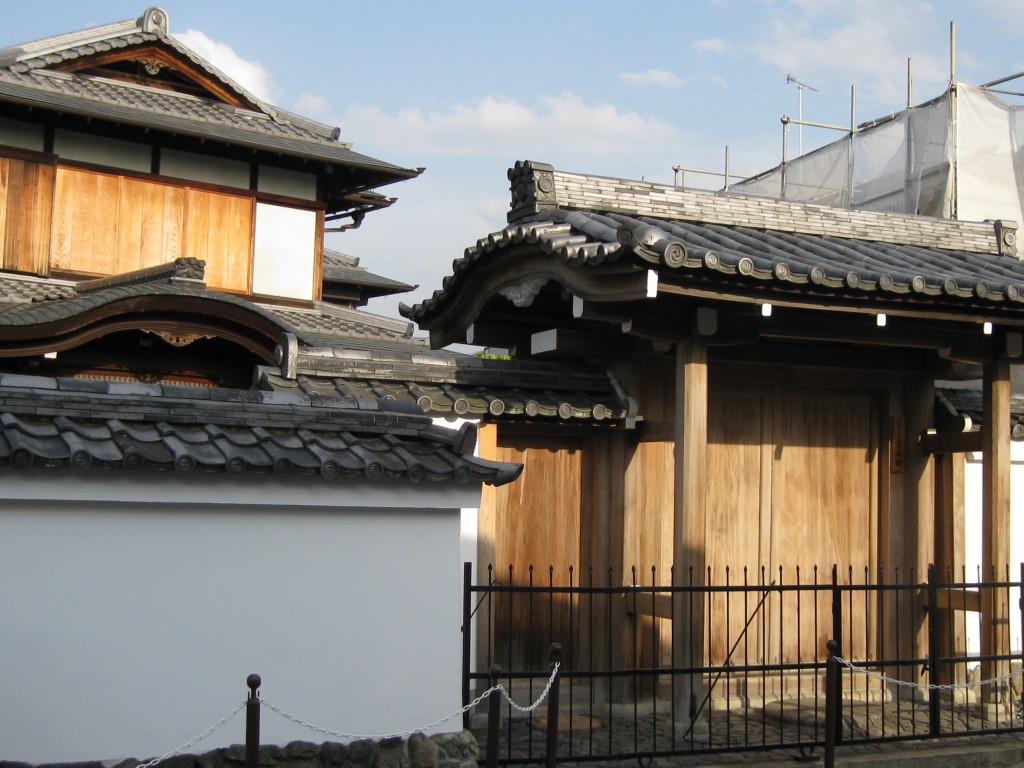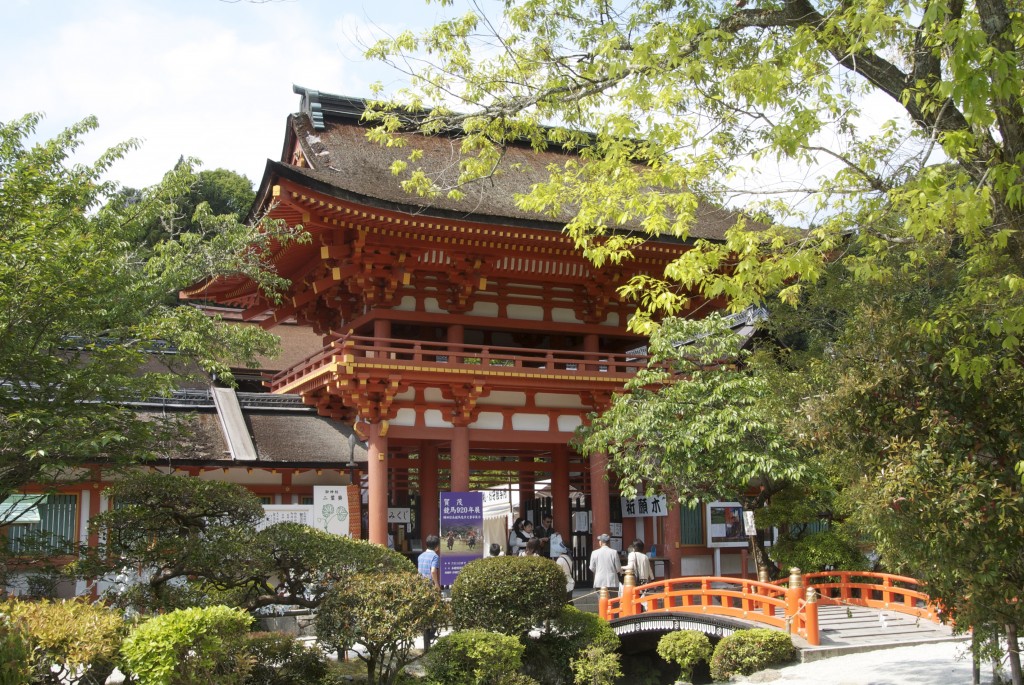Kamigamo Shrine in Kyoto once used to lie well beyond the city limits. It’s one reason why it has managed to retain so much greenery (it still owns several small hills and even the neighbouring large golf course).
Next to the shrine there grew up a small village consisting of shrine personnel and members of the Kamo clan, who first settled the area around the fifth or sixth century. With little streams running through it, the area retains a delightful and distinctive atmosphere even today, though it has been engulfed by Kyoto’s expanding urbanisation. Some of the houses were built specially for Kamigamo priests, and though many have been replaced the article below describes how a foreigner is working to preserve those that are left. (Thanks to Paul de Leeuw for pointing out this article.)

Gert van Tonder bought this 110-year-old house in Kyoto as a wedding gift for his wife.
Living in the Shadow of Shinto Priests
Liza Foreman Published: May 16, 2013 NYTimes
KYOTO — Centuries ago, it would have been difficult for anyone other than a Shinto priest to enter the sacred district of Kamigamo, let alone live here. But now this quaint neighborhood of narrow streets and old houses, nestled between the river Kamo and Kyoto’s northern mountain range, is home to Gert van Tonder, an educator born in South Africa, and his family.
Mr. van Tonder purchased the 240-square-meter, or 2,600-square-foot, property, which included a house and garden, in 2005. It was a present to his wife, Ai, a local artist, following their wedding at the nearby Kamigamo Shrine. They spent the equivalent of $1 million buying and renovating the 110-year-old house, which Mr. van Tonder says is one of the best-preserved homes in the neighborhood.
The house was built of cedar and cypress wood, with bamboo and clay walls, a roof of baked-clay tiles and a stone foundation. It was designed in the sukiya style, which emphasizes naturalism and sometimes is called the Japanese teahouse style.

In the prewar period Shinto scholar Richard Ponsonby-Fane was much taken with the area and resided there for many years
The home was in good condition when Mr. van Tonder purchased it. But to make it more comfortable, he added underfloor heating and improved the bathroom. He also turned the attic into an extra room, now stuffed with toys as a playroom for the couple’s daughter.
“I bought my house from an urban developer,” Mr. van Tonder said. “He did a fair amount of restoration, but he never lived here. He wanted to sell it to somebody who would preserve it as it is, and he had tremendous trouble finding someone.
“Many younger Japanese would love it but would not be able to afford it. The older generation, generally, does not want to live in a traditional house,” he continued. “If he were unable to sell the house, the plan was to demolish it and create a parking lot — a very common fate for old houses in Kyoto.”
The house consists of five main rooms in addition to the attic playroom. Just to the left of the main entry door is a large, sparsely decorated tatami room, which is used as a living and sleeping area and for Mrs. van Tonder’s painting. Its floor-to-ceiling windows offer broad views of the garden, which Mr. van Tonder brought back to life and is one of his favorite pastimes. It contains more than 60 varieties of moss and 20 kinds of small wild orchids.
“Nobody thinks that a foreigner can maintain a garden here,” he said, explaining that he became fascinated with moss as a child and developed a desire to move to Kyoto when he realized that he might find lots of it there.
To the right of the tatami room, there is a modern kitchen that overlooks the garden, and beyond a room stuffed with futons. The bathroom has a cedar tub and a small toilet room. Since completing the renovations a few years ago, Mr. van Tonder, an associate professor in the Department of Architecture and Design at the Kyoto Institute of Technology, has become interested in saving and restoring other neighborhood houses.

The house where Ponsonby Fane lived, now taken over and being done up by a company
In the recent past, Mr. van Tonder said, there were many old homes in the area, including at least 400 sha-ke, or shrine houses, built for the Kamigamo priests and dating to the Edo Period (1603 to 1868). Now only 20 of them remain, he continued, the others torn down in Japan’s drive for modernization or because the country’s steep inheritance taxes made it impossible for the next generation to maintain them.
“One of the distinct features of the sha-ke houses are their white facades with black wooden latticework, like a Tudor house,” Mr. van Tonder said. “The houses are divided along the length into two halves, one with a ground floor and another with a raised tatami floor. Each half has its own front door — the lower door serving for peasants, the upper door for official visitors. The sha-ke houses are surrounded and hidden by high clay walls.”
The professor now is working on plans to ask some of Kyoto’s larger businesses and other companies overseas for donations to buy some of the surviving homes, which he wants to use for a small architectural research center. While the Kyoto city government designated one of the houses he wants to save as a “cultural asset of highest significance,” there has been no additional support, he said.
“These houses are in a neighborhood that existed as a village for the last 1,500 years — that is three centuries before Kyoto was founded as a city and capital of Japan,” Mr. van Tonder said. “The architecture of the old dwellings is a blueprint for much of the quintessential sophisticated Japanese architectural design famous from the 1700s onwards.”
“I personally consider the whole area a zone of very high cultural and architectural significance,” he said. “If preserved properly, by 2050 it will definitely be a Unesco heritage site that will be on the list of everyone visiting Kyoto.”
********************************************************
For a report on Kamigamo Shrine, see here or an account of its horse race see here.
For more about Ponsonby-Fane, click here.

Kamigamo Shrine, a World Heritage site, is the area's biggest landowner and dominates the activities of the neighbourhood to its south, where descendants of the original Kamo clan can still be found.

That’s a cool story, I have strolled that neighborhood many a time, fascinating